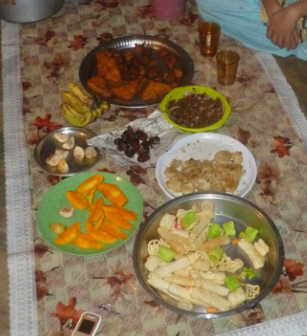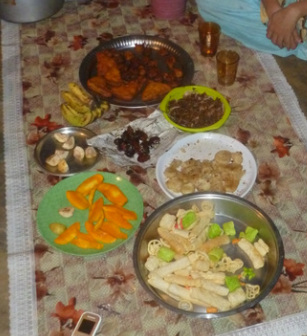Then, in the early afternoon, preparations begin for aftar (or iftar), the fast-breaking snacks that everyone eats in the evening before going to pray namaz and later having dinner. I spent hours at my friend’s house learning how to make the chana (spicy chickpeas), pakori (onions deep-fried in spicy chickpea flour), tamarind chutney, papar (deep-fried potato chips), and sarbat (lemonade) that people eat at iftar, along with fruit and dates and other tasty snacks. That evening, another family invited us to come over and break the fast with them. The mother of the family waited patiently for the azan, lost in silent prayer, while the younger children restlessly awaited the voice over the loudspeaker that would signal it was time to dig in. The call rose from the nearest minaret in melodic Arabic, “God is great…” and along with the thousands of others sitting together in their own houses throughout the community, we broke our fast with a date, then lemonade, fruit, and all the deep-fried goodness on the plates in front of us.

aftar (“iftar” in Arabic), fast-breaking food
One night, we were invited to the home of a wealthy Muslim lawyer who lives nearby our slum and invites anyone who wants to come—mostly poor people from our community—to eat aftar, biryani, and sweets at his house. Despite our not having fasted and our complete ignorance of how to pray namaz, we were welcomed to eat, to watch, and to talk. That open feast for the poor reminded us a bit of the kind of party Jesus describes in Luke 14:12-14. Right after that grand feast, we had the experience of breaking the fast in a more humble setting with friends of ours who hadn’t made aftar most nights at all because of the expense. We chipped in supplies and they did most of the cooking, teaching me how to make even more kinds of ramazan treats. I love the patience and the devotion to God, the sacrificial hospitality, and the vigor of celebration that I saw in the way my neighbors observe Ramazan.
On the second day, we participated in another Eid tradition: big family outings to different parks and attractions around the city. We went with a large family to the zoo, and since one of the sons in the family makes his living as an auto rickshaw driver, all 13 of us piled into his auto for the half-hour trip! The zoo was, well, a zoo—that’s really the best way to describe the atmosphere of noisy crowds packed in everywhere. I think at least a hundred other people from our slum must have been there; we ran into people we knew everywhere. It was a lot of fun to go around to all of the different exhibits with these incredibly excited kids (and excited parents) who had never been to a zoo in their lives and were fascinated by each new creature.
